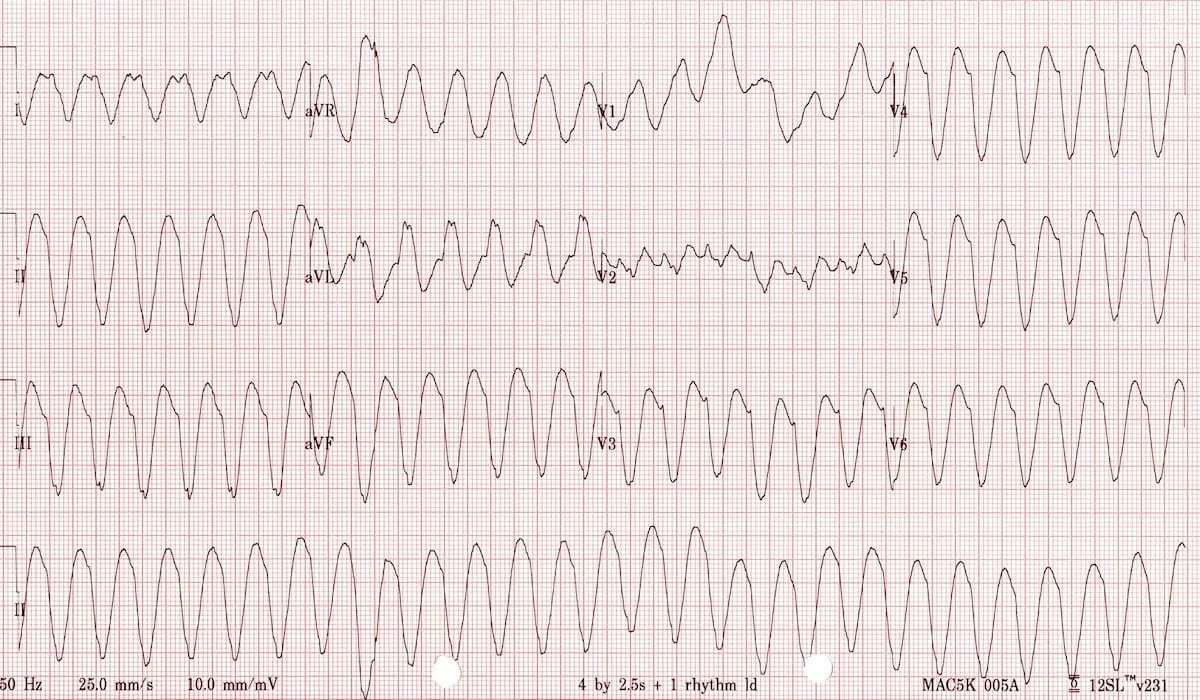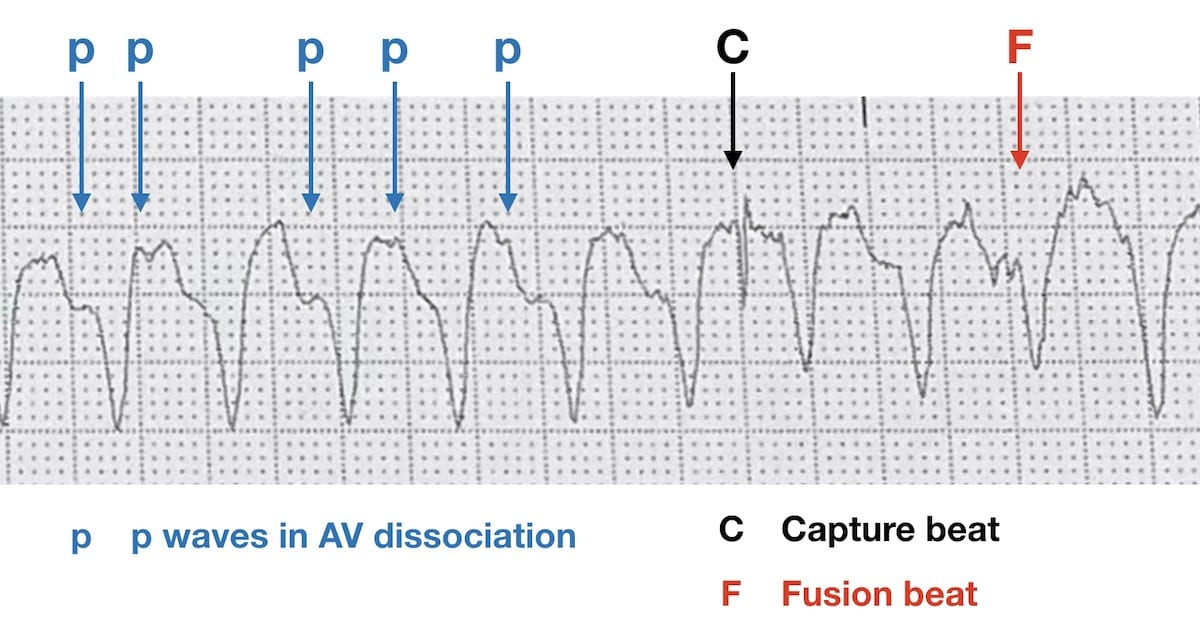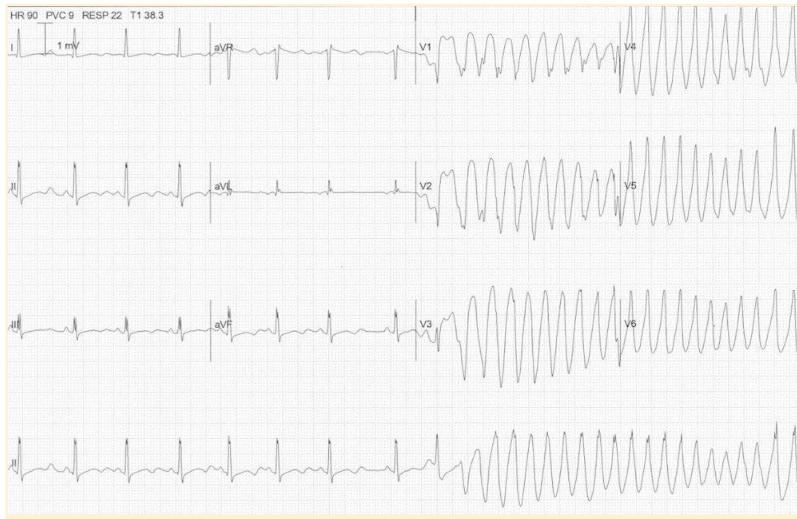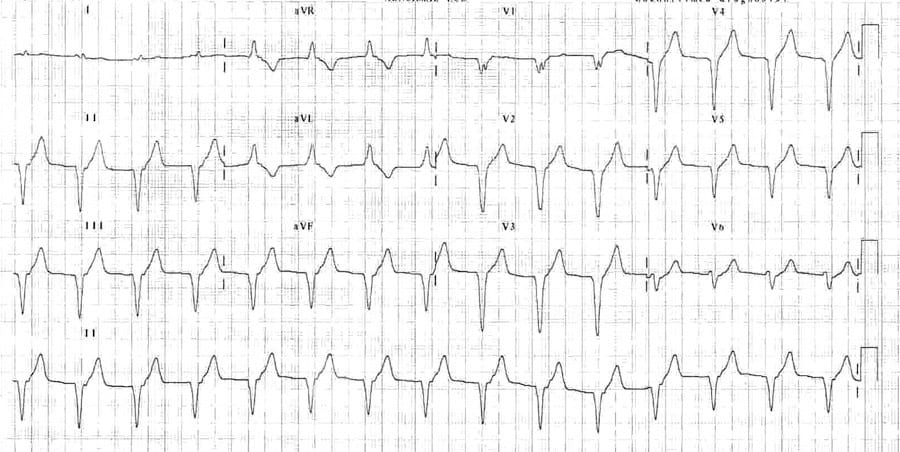Types of Ventricular Tachycardia
The three types of VT are categorized by morphology, clinical significance, and causative factors.
Monomorphic Ventricular Tachycardia
The most common form of VT is monomorphic. Sustained monomorphic VT is produced after a premature ventricular contraction. It has a ventricular rate of 130–240 bpm and can be regular or slightly irregular.
A “post-tachycardia pause” appears if the VT spontaneously resolves (except with atrial fibrillation). The QRS pattern in monomorphic VT has a left or right bundle-branch block morphology.
Ventricular flutter is a form of VT in which ventricular repolarization can no longer be differentiated from ventricular depolarization. Ventricular flutter has a “sinus-form-like” pattern.
Monomorphic VT is caused by coronary heart disease. Patients with left and right ventricular diseases, such as congenital heart disease or ventricular dysplasia, are more susceptible to VT.
Sometimes individuals without any structural heart disease present with VT. They are diagnosed with idiopathic VT if shown to be in a sinus rhythm. These patients show a focus in the right ventricular outflow tract during electrophysiology studies. The ECG tracing shows a left bundle-branch block pattern with right axis deviation on the frontal QRS axis.
Related Video – ECG Rhythm Review – Ventricular Tachycardia
Sustained Monomorphic Ventricular Tachycardia
Wide QRS complexes and AV dissociation are the hallmarks for diagnosing sustained monomorphic VT.

Classic Monomorphic Ventricular Tachycardia ECG 56
The ECG above represents classic monomorphic VT, showing very broad QRS complexes (0.2 seconds). Notching in the S wave in lead III signifies Josephson sign.
AV dissociation is seen in the presence of fusion complexes. Fusion complexes are supraventricular impulses that combine with an impulse from the ventricle.

Fusion Complexes and Capture Beats. 57
AV dissociation is also seen in the presence of sinus capture complexes. These represent a supraventricular impulse that depolarizes the ventricles when they are not in the refractory state before the occurrence of the next ventricular tachycardia-generated complex.
The diagnosis of sustained monomorphic VT can also be made if there is a persistent retrograde block. About 40% of these patients have intact ventriculoatrial conduction, so AV dissociation is not seen. Ventriculoatrial conduction occurs in a 1:1 pattern or together with a second-degree AV block.
Sustained monomorphic VT also has a variable ST and T wave configuration. This represents the superimposed P waves and the changes in ventricular depolarization.
The heart rate in sustained monomorphic VT is typically constant throughout the event but may “warm up” initially and then produce some subtle variabilities in rate.
Polymorphic Torsades De Pointes
Torsades de pointes is a ventricular tachycardia with constant changes in the amplitude of the QRS complexes. The ECG rhythm seems to “twist” around the isoelectric line. Peaky R and S waves appear in the ECG in more than one lead.
Torsades de pointes was first associated with congenital long-QT syndromes, Romano-Ward syndrome (without deafness), and the Jervell and Lange-Nielson syndrome (with deafness). Diuretics can provoke hypokalemia and hypomagnesemia, which in turn can cause torsades de pointes. Antiarrhythmic agents can also provoke torsades de pointes. Torsades is also observed in patients with congestive heart disease.
The ventricular rate in torsades de pointes ranges from 200 bpm to 300 bpm. Heart rates of up to 400 bpm have been reported.
Torsades de pointes may terminate spontaneously after several seconds or minutes. When it lasts for more than 5 seconds, patients will lose consciousness. Longer-lasting tachycardia can cause cerebral damage.
Torsades de pointes can also progress into ventricular fibrillation. Therefore, any patients with torsades de pointes should be monitored and treated promptly. The treatment of choice is magnesium. A temporary pacemaker and defibrillator should be placed on stand-by.

Torsades de Pointes 58
The example in Figure 3 above is from a patient in torsades de pointes. The arrhythmia was triggered after frequent PVCs with an R-on-T phenomenon. At the end of the rhythm strip, the polymorphic VT progresses into ventricular fibrillation.
A prolonged QT interval (computer estimated QTc of 480 milliseconds) confirms the diagnosis of torsades de pointes. Prolonged QTc and frequent PVCs are seen in patients with acute myocardial ischemia. Both put a patient at high risk for progression into polymorphic ventricular tachycardia and ventricular fibrillation.
Polymorphic Ventricular Tachycardia
Torsades de pointes is only one type of polymorphic VT. Other manifestations can occur as well.
Polymorphic QRS complexes may be observed in unsustained ventricular tachycardias, especially if the tachycardia only lasts for several beats. They can also be seen in patients with severe myocardial damage from an MI and may progress into ventricular fibrillation immediately. They can also be seen in patients with cardiogenic shock just before the patient expires.

Torsades de Pointes Secondary to Hypokalemia ECG
The ECG above begins in sinus rhythm with inverted T waves, prominent U waves, and a prolonged Q-U interval, representative of severe hypokalemia. The patient has a serum potassium level of only 1.7 mmol/L.
The 9th beat on the rhythm strip contains a PAC that lands on the T wave. This is an “R-on-T” phenomenon that eventually initiates polymorphic ventricular tachycardia. The prolonged QU interval confirms the diagnosis of torsades de pointes.
Related Video – ECG Rhythm Review – Polymorphic Ventricular Tachycardia (Torsades de Pointes)
Accelerated Idioventricular Rhythm
Accelerated idioventricular rhythm is seen in patients with acute MI during the first hours after thrombolytic therapy or after a coronary artery bypass grafting procedure.
Accelerated idioventricular rhythm generates impulses that overtake the impulses from the sinus node. It occurs at a rate of 60–100 bpm. AV dissociation may be present in which the atrial rate is slower than the ventricular rate. The P-P intervals are longer than the R-R intervals. This characteristic helps distinguish these patients from those with third-degree AV block. In third-degree AV block, the atrial rate is faster (P-P interval) than the ventricular rate (R-R interval), and the P waves are dissociated from the QRS impulses.

Accelerated Idioventricular Rhythm ECG 59
The ECG above represents accelerated idioventricular rhythm. The patient has a heart rate of 90 bpm. There are broad QRS complexes and no visible p waves. The accelerated idioventricular rhythm was produced after reperfusion therapy for an anterior wall STEMI.
Related Video – ECG Rhythm Review – Idioventricular Rhythm
56 Burns E. Ventricular tachycardia—monomorphic VT. Life in the fastlane website. Accessed September 29, 2020.
https://litfl.com/wp-content/uploads/2018/08/Monomorphic-ventricular-tachycardia-VT-8.jpg
57 Burns E. Ventricular tachycardia—monomorphic VT. Life in the fastlane website. Accessed September 29, 2020.
58 Burns E, Buttner R. Polymorphic VT and torsades de pointes (TdP). Life in the fastlane website. Accessed September 29, 2020.
https://litfl.com/wp-content/uploads/2018/08/ECG-strip-Torsades-de-pointes-TDP-2-2-768×109.jpg
59 Burns E, Buttner R. Accelerated idioventricular rhythm (AIVR). Life in the fastlane website. Accessed September 29, 2020.
https://litfl.com/wp-content/uploads/2018/08/Accelerated-Idioventricular-Rhythm-AIVR-ECG-5.jpg